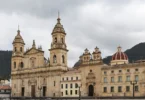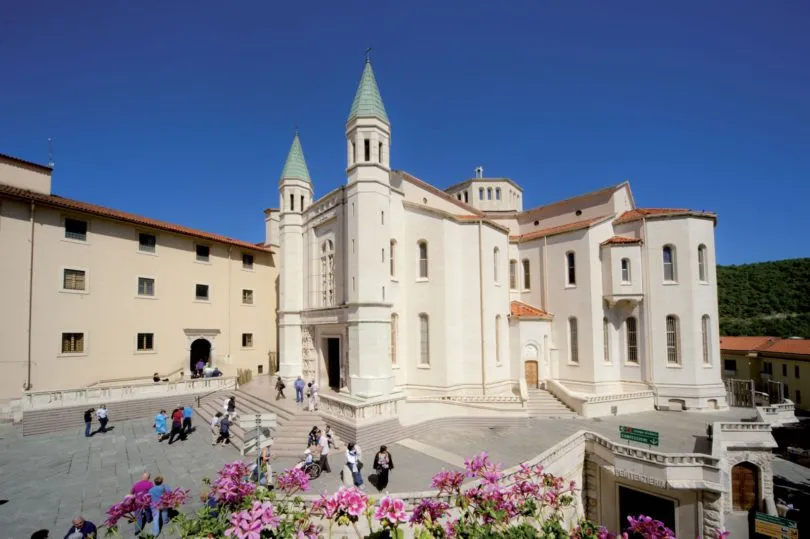
Introduction
Basilica di Santa Rita da Cascia lies in the beautiful region of Umbria in central Italy. This basilica is a testimony to the exceptional life of Saint Rita, a beloved Catholic saint known for her miraculous acts and holy piety. The church’s Romanesque-Gothic-Baroque architecture is delightful, decorated with statues, and sculptures that add to its charm. The interior is adorned with frescoes, paintings, and marble works that exude a spiritual aura effect. The main altar houses relics of Saint Rita, attracting countless pilgrims, and visitors worldwide, who admire her role as the “Saint of the Impossible.” From the 14th century, Saint Rita’s devotion is prevalent in Cascia, where she spent her life as an Augustinian nun. Her unwavering faith, forgiveness, and miracles attributed to her intercession make her one of the most venerated saints worldwide.
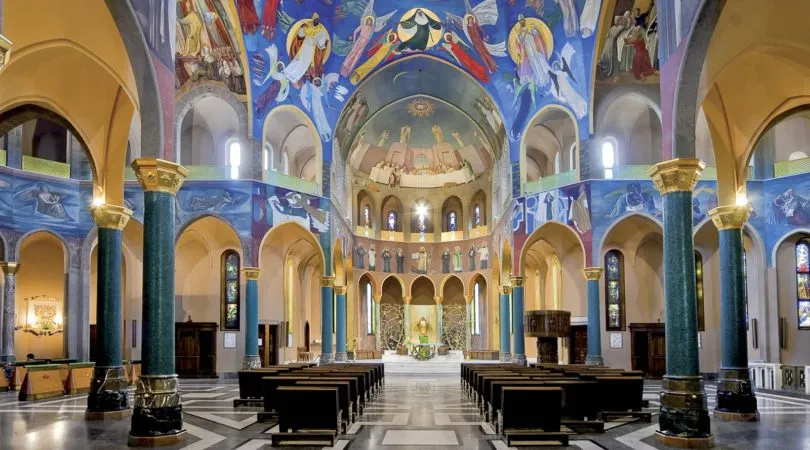
St. Rita of Cascia, Italy was built in the first half of the 20th century, in memory of the Saint. As for the Monastery, which dates back to 1200, it is precisely the one where she lived in the first half of the 15th century. A colorful church, but at the same time a place of worship, but also of art. The chapel of Saint Rita is located behind a large iron railing where there is an urn with his body inside.
The devotion to Saint Rita of Cascia dates back to the 14th century when she lived as a widow and Augustinian nun. Saint Rita is venerated for her unwavering faith, forgiveness, and the miracles attributed to her intercession. She is especially known for her role as the “Saint of the Impossible” due to the numerous stories of seemingly hopeless situations that were resolved through her intercession.
The Basilica of Saint Rita was built over the original convent where Saint Rita lived, and her relics were transferred to the basilica in 1937. The church has been expanded and renovated over the centuries, reflecting the devotion and popularity of Saint Rita among the faithful.
The original project by Msgr. Spirito Chiapetta was subsequently modified by Giuseppe Calori and Giuseppe Martinenghi. On 20 June 1937, Cardinal Enrico Gasparri laid the first stone. Just ten years later, on 18 May 1947, the church is consecrated. Elevation to Basilica takes place on 1 August 1955 by Pius XII.
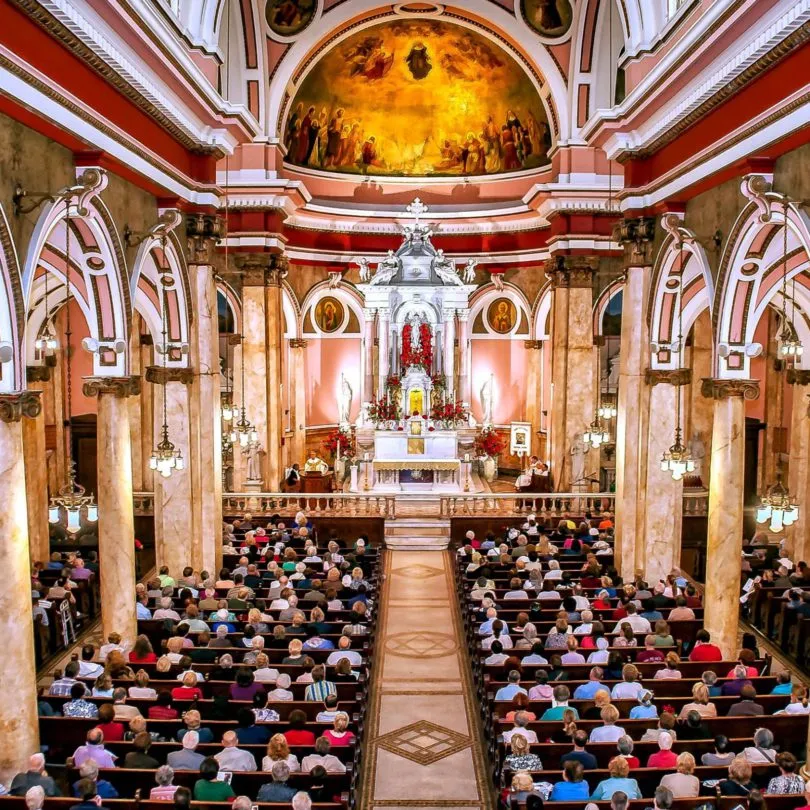
Nestling on the Sant’Agostino hill, the façade is covered with the pure white of Tivoli travertine marble. The interior of the Basilica of Saint Rita of Cascia, in the form of a Greek cross, consists of a central dome and four large apses.The columns support the matroneum reserved for the prayers of the Augustinian nuns. The windows are by Armando Marrocco.
The central dome is frescoed by Luigi Montanarini: the dove, symbol of the Holy Spirit, stands out in the centre while all around it radiates the glory of the Augustinian saints.In the main apse, the presbytery is adorned with bronze sculptures by Giacomo Manzù: the tabernacle, olive branch-panels, altar table, crucifix, ambo and Eucharistic lamp. The frescoes are by Luigi Filocamo.
The entrance apse is embellished with frescoes by Silvio Consadori and by the side altar of St. Joseph with the baby Jesus, created by Cesarino Vincenzi.The fresco by Gisberto Ceracchini shines in the apse of the Assumption. The Virgin ascends to heaven surrounded by festive angels waving lilies.
The altarpiece by Giuseppe Valerio Egger depicts Our Lady of Consolation, sitting on the throne with the Child on her knees while, to the side, Saint Augustine and Saint Monica receive the belt, symbol of the Augustinian family.
The apse of Saint Rita was frescoed by Ferruccio Ferrazzi (“Saint Rita in Glory”). At the centre is the Christ Judge seated on a throne with a luminous cross at his back. At his feet, Saint Rita gently rests her head on the Saviour’s knees; humble and trusting, she intercedes for grace and mercy for her devotees.
The dome with the dove, symbol of the Holy Spirit, and the glory of the Augustinian saints is by Florentine Luigi Montanarini.
The composition is continuous and goes from the lantern to the sails, to the masts; it covers an area of about 300 square meters and is painted in true fresco. In the sails, in the middle of groups of angels in multi-colored clothing, you can see Saint Rita, St. Augustine, St. Clare of Montefalco, St. Nicholas of Tolentino, Blessed Simon of Cascia, St. John of Sahagùn, Blessed Juliana of Cornillon, St. Thomas of Villanova.
On the masts, again in neo-Byzantine style and with bright colors and elongated figures, Montanarini has painted the passing of Saint Rita, her canonisation, the works of St Rita, and the elevation of the Sanctuary to Basilica.
Chapel of Saint Rita with her body
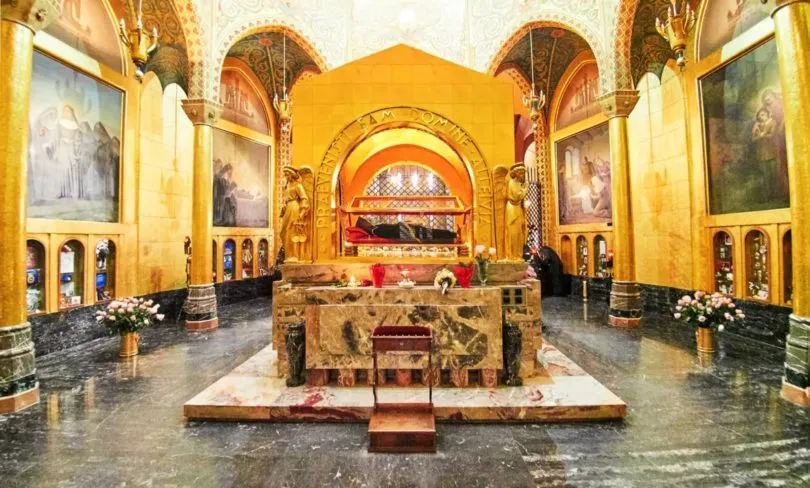
Behind the large wrought iron lattice, you can see the chapel of Saint Rita, in neo-Byzantine style.The urn of 1930 containing the body of Saint Rita was placed here on 18 May 1947. On the marble base, Eros Pellini has carved Saint Rita dispenser of graces; the votive lamp in bronze, a gift of the municipality of Cascia in 1981, is the work of Artemio Giovagnoni from Perugia.
Represented by four angels on the four outer sides of the ark that contains the urn are the cardinal virtues: temperance, courage, justice, prudence (courage, the Angel with shield and sword, and temperance, the Angel with jug and cup, are visible from outside the fortress).
On the arch, a phrase in Latin is legible: “Posuisti in capite eius coronam” (He has placed the crown on his head).The chapel friezes, the columns of the ex-votos in niches, the lamps that hang from the arches and the soft light that enters from above, give a sensation of mysticism and preciousness.
Along the walls, it is possible to admire seven valuable canvases by Giovan Battista Galizzi of Bergamo. Starting from the left: the birth of Saint Rita and the bees, Rita and her sons before the crucifix, entry into the monastery, test of obedience, stigmatization, pilgrimage to Rome, passing of Saint Rita.
Golden Urn
The Baroque-style golden urn, which can be seen at the back of the cell where the wedding ring, is placed, was donated by the Malaspina noble family of Ascoli Piceno. It contained the body of Saint Rita from 1745 to 1930 and was brought here from the old church of the monastery; the crown and the monastic habit, which can be seen inside the urn, were previously on the body of the saint.
Saint Rita’s Cell
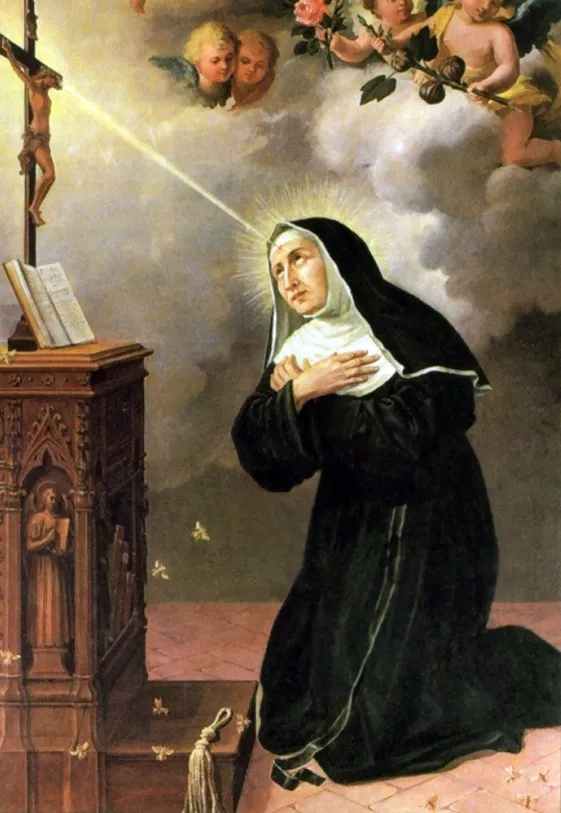
Next to the wedding ring cell, is the frugal and narrow cell of Saint Rita, with the wooden sarcophagus, the so-called “solemn case”, which contained the body of the saint from around 1475 until 1745.
The saint rested in this cell, often devoting part of the night in prayer and contemplation of the Passion of Jesus.
The oldest evidence, such as the ex-votos examined one by one in the process of beatification of 1626, allow us to state that Rita took the Gospel’s invitation to be vigilant very seriously: she wore sackcloth day and night, and often fasted on bread and water, giving everything to the Lord. In her last years, very ill and no longer able to walk, she remained almost always in this cell, illuminated only by a small window, to left on high.
The Solemn Case
Dates back to 1457-1462. According to very reliable testimonies from the proceedings of 1626, it was made (very probably on commission) by Mastro Cecco Barbari da Cascia who, with crippled hands, was cured by visiting the body of the saint. This sarcophagus contained the body of Rita from 1457-62 until 1745. Inside, it contains the “humble case”, Rita’s first coffin.
The solemn case represents the first relevant evidence about Saint Rita: this is the oldest depiction of the saint which, presumably, shows us her physical features. The sarcophagus also reveals the historicity of the stigmata, providing a valuable testimony of the worship that started a few years after the death of the Saint.
The front panel, divided into three segments, shows St. Mary Magdalene, Christ, and Saint Rita, dressed as an Augustinian nun, radiating rays of light from her head; on her forehead is the sore, in her right hand a big thorn and in her left hand a small rosary crown. The face, expressive and joyful, inspires intelligence and strength.
On the sloping cover there is Rita lying peacefully on her deathbed and, next to her head, there is an epitaph (a phrase of praise extolling the virtues of the saint).
The Remarkable Feature Of Basilica of Saint Rita
The Basilica di Santa Rita da Cascia holds immense spiritual significance as it is dedicated to Saint Rita, the patron saint of impossible causes. Saint Rita’s life was marked by her devout faith, her act of forgiveness, and her reputation for performing miracles, making her one of the most revered saints in Catholicism. The basilica honors and commemorates the life and deeds of Saint Rita, providing a sacred space for pilgrims and visitors to connect with her spiritual legacy.
It is believed that Saint Rita’s incorrupt body rests in the silver urn of the Shrine of the Rose, which is a significant center of devotion inside the basilica. With its awe-inspiring architecture, paintings, and sculptures, the basilica offers a breathtaking holy environment that inspires awe and reverence, reminding visitors of the power of divine intervention. The basilica’s spiritual significance extends far beyond its physical beauty as it serves as a testament to the enduring legacy of Saint Rita and her unwavering faith in God’s goodness.
The remarkable feature of the basilica is its 14 chapels, each of which is dedicated to a particular saint. These chapels contain relics, paintings, and sculptures of the saints to whom they are dedicated.
One of the most famous works of art in the basilica is the wooden statue of Saint Rita, which dates back to the 14th century. This statue portrays Saint Rita in her habit, holding a crucifix and a thorn, symbols of her life and suffering. The statue is beautifully carved and has become an object of great veneration among the faithful.
Eucharistic Miracle
The Eucharistic Miracle is kept in the stone and crystal tabernacle, flanked by two marble panels depicting the two sides of an open book. In 1330 in Siena, a priest called to take Holy Communion to a sick person placed the host in his breviary.
At the sick person’s home, he saw that the host had turned into blood. He went to confess what had happened to blessed Simon, who took the relic to Cascia.
In 1389, Pope Boniface IX confirmed the authenticity of the miracle. The fragment of parchment paper measures 52 x 44 mm. Looking against the light, it can be seen that the blood stains have formed the outline of a human face.
The beautifully rough-hewn stone sarcophagus contains the remains of Blessed Simon of Cascia. Born in Cascia in around 1285, while still a young man, he left his comfortable life to enter the Order of Saint Augustine.
Ordained a priest, he was a great preacher and spiritual guide; a writer in Latin and Italian, he has left us precious writings on theology and spirituality. He died in Rome on 2 February 1348 and his feast is celebrated on February 16.
The Basilica of Saint Rita in Cascia is not just a place for worship but also a site of miracles. One of the most remarkable features of the basilica is the Eucharistic Miracle. The Eucharistic Miracle is kept in the stone and crystal and is related to a miracle that happened over 750 years ago.
The miracle occurred when a woman who had doubts about the transubstantiation of the Holy Eucharist received the Sacred Host. To her amazement, the Host turned into visible flesh and blood. The relics of this miracle are still present in the basilica to this day and have been authenticated by the Church. This miracle is also one of the reasons why the Basilica of Saint Rita has become such a revered pilgrimage destination.
The Crucifix Oratory and the Rose Garden
The crucifix oratory, where tradition says that Saint Rita received the thorns on her forehead. The wonderful rose garden, the door next to Saint Rita’s cell, and the Saint Rita rose garden, created in memory of the miracle of roses and figs. The rose is the symbol of excellence, it indicates that Saint Rita managed to bloom, despite the thorns that life has reserved, giving the fragrance of Christ and melting the winter ice of so many hearts. The two figs, however, most likely represent her children and the realization that you are, in spite of everything, safe.
You can see the image of Saint Rita in this sacred resting room, often dedicated to the night of prayer and contemplation of the Passion of Jesus. In another image you can see the Saint’s wedding ring, formed by two hands joined in a sign of loyalty and the Rosary. The two images are the urn that contains the body of the Saint and the other is the urn with the wedding ring.
Famous art and architecture inside the Basilica
The Basilica di Santa Rita da Cascia is a stunning example of Romanesque, Gothic, and Baroque architecture. The grand facade is adorned with statues and sculptures, and the bell tower creates an idyllic old-world charm. Inside, the Basilica is a magnificent sight to behold. The frescoes, paintings, and marble works are richly detailed and create an atmosphere of deep spirituality and reverence. One of the key features of the Basilica is the Shrine of the Rose, which houses the silver urn containing the incorrupt body of Saint Rita, the Saint of the Impossible.
The shrine is a focal point of devotion for those seeking to ask for Saint Rita’s intercession. Of particular note is the Apse of Saint Rita, which features a fantastical view of Christ the judge, flanked by angels, with Saint Rita resting her head on his knee. The Triumphal Arch illustrates two key episodes from the life of Saint Rita – her healing from stigmata on her forehead, and her pilgrimage to Rome in 1450 for the Holy Year at the feet of Pope Nicholas V.
Apse of Saint Rita
Roman artist Ferruccio Ferrazzi imagines that a magnificent view opens up over the roofs of Cascia, contemplated by a shepherd guarding the flock (left of the observer). At the center of the vision is Christ the judge, sitting on a throne with a glowing cross behind him. At his feet, Saint Rita gently rests her head on the knee of the Saviour.
Humble and confident, she intercedes for grace and mercy for her devotees. All around, a host of angels swirls in a beautiful play of light and color. To the right of the observer, the rock of Roccaporena with Rita as a child in the clouds, a gift of heaven to our earth.
The triumphal arch shows two episodes from Rita’s life: Rita heals from the stigmata on her forehead; Rita as a pilgrim to Rome for the Holy Year in 1450 at the feet of Pope Nicholas V. In the area of the women’s gallery is the theological and cardinal virtues.
On the right, against the wall, there is a small picture of Our Lady of Good Counsel (XVIII century) and the parchment of the decree by which Pio XII elevated the church to the basilica on 1 August 1955.
Feast Day - 3rd Sunday of January
The annual feast of Basilica di Santa Rita da Cascia is celebrated on 3rd Sunday of January.
Mass Timing
Weekdays:
- 7.30 am
- 10.30 am
- 12.00 noon
- 4.00pm
- 6.00pm
Weekend days:
- 7.30 am
- 9.00 am
- 4.00 pm
- 6.00 pm
On public holidays the Mass is also celebrated in the Hall of Peace during the following times:
- 10.00 am
- 11.00 am
- 12.00 noon
Contact Info
Viale Santa Rita, 13 – 06043 Cascia (PG) Italy
Phone No.
Accommodations
How to reach the Sanctuary
Railways
The nearest Railway station is Spoleto which is 127 kilometre from the Basilica of Santa Rita da Cascia,Italy.
Airways
The nearest Airport is Perugia (PEG) which is 43.9km from the Basilica of Santa Rita da Cascia,Italy.


